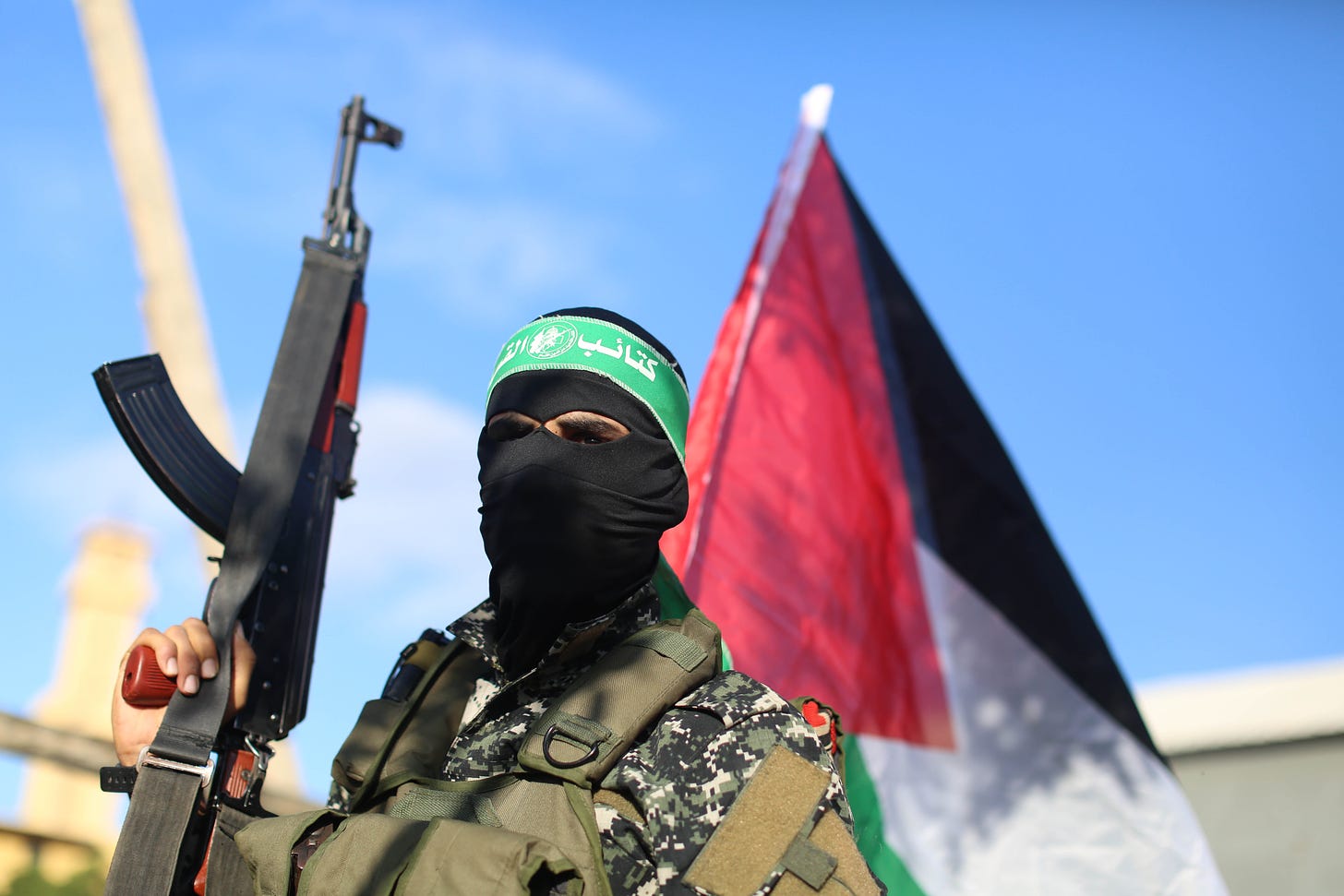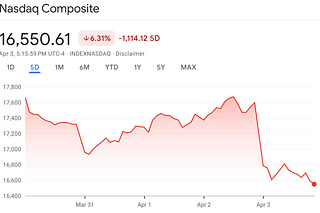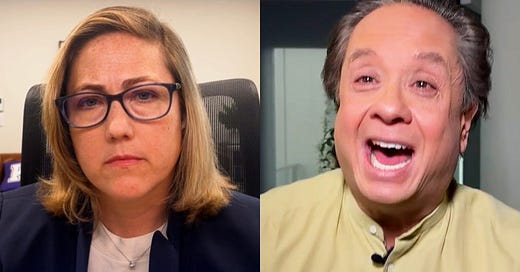
When Hamas Tells You Who They Are, Believe Them
The terrorist group is clear about its goals and tactics. Why do so many in the West still misunderstand it?

ANYONE WHO HAS READ THE original Hamas charter knows it’s a reeking stew of paranoid antisemitism and genocidal fantasies about world domination. But if you suggest that these ideas are what motivated the eruption of mass murder, kidnapping, and rape in southern Israel on October 7, you won’t get a hearing from many of the progressives who call themselves friends of Palestine.
A coalition of student groups at Columbia University recently published a statement about the October 7 assault titled “Oppression Breeds Resistance.” The title captures the authors’ central message—that the slaughter of civilians was an understandable and even legal act of resistance by a desperate people: “We remind Columbia students that the Palestinian struggle for freedom is rooted in international law, under which occupied peoples have the right to resist the occupation of their land.” According to the students, Hamas isn’t to blame for the massacre: “The weight of responsibility for the war and casualties undeniably lies with the Israeli extremist government and other Western governments, including the U.S. government.” Other statements churned out by elite students in recent weeks made similar arguments—a collection of Harvard “solidarity groups,” for instance, declared that Israel is “entirely responsible” and the “only one to blame.”
Students aren’t the only ones with this blinkered view of the killing spree in southern Israel last month. On October 30, faculty at Columbia University published an open letter in defense of the students whose statement had (according to the authors) innocently “situated the military action begun on October 7th within the larger context of the occupation of Palestine by Israel.” The letter never uses the word “terrorism,” but it variously refers to Hamas’s attack as a “military action,” a “military operation,” and a “military response by a people who had endured crushing and unrelenting state violence from an occupying power over many years.” The letters and statements repeatedly refer to “the people” of Palestine, the “Palestinian struggle,” etc.—a rhetorical trick which conflates all Palestinians with Hamas.
Why would self-proclaimed supporters of the Palestinians do this? Shouldn’t they make a clear distinction between Hamas and Palestinian civilians who bear no responsibility for the gruesome attacks on October 7? This distinction is particularly important at a time when thousands of civilians are being killed by IDF operations in Gaza—and many thousands more will die in the weeks and months to come.
The error of conflating Hamas and the Palestinians isn’t confined to the left. As the carnage piles up and the hospitals overflow, many intellectuals and politicians on the right are arguing that there’s little distinction to be made between Hamas and innocent victims in Gaza. Alan Dershowitz recently published a video in which he implores his audience to “Remember that the citizens of Gaza, these innocent civilians who so many people are shedding tears about, they voted for Hamas in the last election. . . so when you look at these civilian deaths, you have to ask yourself a question: how many of them really are civilians?” Arkansas Sen. Tom Cotton recently announced that “Anyone who claims to support the people of Gaza but not Hamas should remember that Gazans elected Hamas.” Sixty-five percent of the Gazan population is under 24 years old, and the last election was held in 2006. And, by the way, while Hamas received plurality support in those elections, it fell short of a majority. Hamas only took full control of Gaza in a violent coup in 2007.
While it’s true that a horrifying proportion of Palestinians support violence against Israeli civilians (especially in Gaza), this doesn’t mean Israel should relax its standards for avoiding civilian casualties. But this is exactly what some politicians are demanding. In a recent speech on the U.S. House floor, Florida Rep. Brian Mast compared Palestinians to Nazis and suggested that the concern over civilian casualties is exaggerated: “I would encourage the other side to not so lightly throw around the idea of innocent Palestinian civilians, as is frequently said. I don’t think we would so lightly throw around the term innocent Nazi civilians during World War II.” This is extremely dangerous language—civilians are civilians, even if they hold abhorrent views. Of course, many Palestinians don’t support violence against Israeli civilians, while many others are babies or children. The only responsible course of action is for the IDF to avoid civilian casualties just as scrupulously in Gaza as anywhere else.
Like those who rationalize the collective punishment of noncombatants, the professors and students at Columbia and Harvard don’t make a distinction between Hamas and Gazan civilians. In their recent statements, “Israel” appears 34 times, “Palestine” appears 42 times, and “Hamas” doesn’t appear once. As far as the authors are concerned, Hamas isn’t an organization with its own history, ideology, and political goals—it’s a nameless and faceless manifestation of Palestinian grievances.
The Columbia faculty letter observed that “One could regard the events of October 7th as just one salvo in an ongoing war between an occupying state and the people it occupies, or as an occupied people exercising a right to resist violent and illegal occupation, something anticipated by international humanitarian law in the Second Geneva Protocol.” The failure to attribute responsibility to the actual perpetrators of October 7 doesn’t just lead to profound moral and political confusion—it blurs the line between combatant and noncombatant.
TOO MANY OBSERVERS AND COMMENTATORS overestimate the autonomy and agency of the Israeli government while treating Hamas as furniture, devoid of any agency at all, a mere fact of life. There are good reasons why a ground invasion of Gaza to destroy Hamas as a political and military organization will be a tragedy for Israel and cost lives, resources, and goodwill. Yet none of the arguments for Israel to leave Hamas intact deals adequately with the political realities of war in a democracy: The Israeli government can shape the war, but politically, it cannot allow Hamas to remain a threat any more than Franklin Roosevelt could have ignored the Japanese attack on Pearl Harbor or George W. Bush could have ignored September 11.
Hamas has at least as much autonomy as Israel—possibly more, because its rule rests on violence rather than its ability to respond to the wants and needs of the population. And yet its motives somehow elude many in the West.
The Columbia faculty letter states that students merely wanted to “recontextualize” October 7 by placing it within the “larger context of the occupation of Palestine by Israel.” But there’s a different context neither the faculty nor the students want to face, encapsulated by a quotation at the beginning of the Hamas charter: “Israel will exist and will continue to exist until Islam will obliterate it, just as it obliterated others before it.”
This eliminationist mission statement is central to Hamas’s identity. A member of Hamas’s senior leadership and political wing, Ghazi Hamad, recently declared that the organization would launch “a second, a third, a fourth” attack à la October 7 until Israel is “annihilated.” He continued: “Israel has no place on our land,” by which he means not just Gaza but all the land currently constituting the territory of Israel. “We must remove the country because it constitutes a security, military and political catastrophe.” These aren’t the words of an oppressed freedom fighter who’s “exercising a right to resist violent and illegal occupation.” They’re the words of a hateful theocrat who wants to obliterate the state of Israel. Hamas doesn’t represent the “Palestinian struggle for freedom” which is “rooted in international law.” It represents the same genocidal obsession and paranoia that have motivated antisemitic atrocities throughout the generations.
Article 22 of the Hamas charter accuses Jews of amassing “great and substantive material wealth” which allowed them to seize “control of the world media, news agencies, the press, publishing houses, broadcasting stations, and others.” The document claims that Jews were behind the French Revolution, the Russian Revolution, Western imperialism, and both world wars. “There is no war going on anywhere,” the charter declares, without Jews “having their finger in it.” It cites the Protocols of the Elders of Zion—the forgery that fueled so much fanatical antisemitism throughout the twentieth century—as evidence that “Zionists aspire to expand from the Nile to the Euphrates.” This is why Hamas believes the “fight with the warmongering Jews” is incumbent upon all Muslims and regards itself as the “spearhead of the circle of struggle with world Zionism.” (Notice, the charter, published in 1988, doesn’t specify Israelis as Hamas’s enemy, but Jews. Where campus leftists see a political struggle, Hamas sees a religious one.)
Hamas made no secret of its genocidal ambitions over the past three and a half decades. Yet students at Columbia University issued a statement condemning a “series of fascist, racist, and colonial Israeli governments” without mentioning the fascist ideology of the organization that just murdered 1,400 people on Israeli soil.
Ask left-wingers to explain what motivated atrocities like the 2019 Christchurch mosque shootings in New Zealand or the 2015 massacre at a black church in Charleston, South Carolina, and they will rightly point to bigotry and white supremacist ideology. But when one of the world’s most vicious antisemitic organizations goes on a medieval rampage in Israel, racism and ideology suddenly have nothing to do with it. Like the Christchurch shooter (who live-streamed his mass shooting), Hamas “fighters” documented their own sadism with body cameras and cellphones. They filmed themselves hacking at a defenseless man’s throat with a garden hoe. They got footage of entire families being blown apart by their grenades. “The videos show pure, predatory sadism,” Graeme Wood writes in the Atlantic, “no effort to spare those who pose no threat; and an eagerness to kill nearly matched by eagerness to disfigure the bodies of the victims.” But Wood says he was most disturbed by a recorded phone call from one of the terrorists to his parents in Gaza:
He tells his father that he is calling from a Jewish woman’s phone. (The phone recorded the call.) He tells his father that his son is now a ‘hero’ and that ‘I killed 10 Jews with my own hands.’ And he tells his family, about a dozen times, that they should open up WhatsApp on his phone, because he has sent photographs to prove what he has done. ‘Put on Mom!’ he says. ‘Your son is a hero!’
As the parents urge their son to come home, he shouts “Allahu akbar” and declares that he will achieve “victory or martyrdom.” These aren’t the actions of a soldier taking part in a “military operation”—they’re the actions of a savage zealot who believes murdering Jews is his highest spiritual calling. The terrorists who descended on southern Israel last month weren’t thinking about the Second Geneva Protocol when they stalked from home to home and killed or captured every human being they found. They were thinking about glory, martyrdom, and genocide.
EVEN THOSE WHO RECOGNIZE Hamas’s evil too often misunderstand it. They make the error of assuming that the enemy is basically like us, and this leads them to confuse Hamas’s means with its ends.
In a recent article for the Washington Post, Shadi Hamid argues that it’s a “mistake to dismiss Hamas’s terrorism as mere ‘evil,’” because doing so obscures why Hamas behaves as it does, which could lead to policies that further alienate Palestinians, foment radicalism, and increase the likelihood that “violent organizations will take Hamas’s place even if the group is neutralized or somehow eliminated.” He continues:
To describe the things we can’t comprehend as evil is a cop-out. It allows us to believe something is wrong with ‘them’ but not with us. And, paradoxically, it exposes an unwillingness to take terrorists seriously, reducing them to ‘crazy’ or ‘irrational’ adversaries. They usually aren’t.
When the perpetrators of atrocities film themselves gunning down civilians in their homes and at music festivals, then send the footage to family members as trophies, “evil” is a word that will come to mind whether you want it to or not. But this doesn’t preclude an honest effort to comprehend Hamas’s motivations. For example, Hamid observes: “Through spectacular violence and brutality, Hamas seized the initiative and demonstrated its own relevance.” While this is difficult to deny, it reduces Hamas’s spectacular brutality to the status of a mere political instrument. Hamid cites his colleague Damir Marusic, who describes the October 7 attack as an “act of breathtaking cynicism.” Marusic appears to regard the massacre as a political strategy: “The sacrifice of tens of thousands of lives of their fellow Palestinians,” he wrote, “would be a worthy price to pay to remain in power.”
To the extent that the October 7 attack was intended to achieve specific political goals—such as disrupting the nascent relationship between Israel and Arab states or damaging Israel’s reputation with an inevitable flood of civilian casualties in Gaza (Marusic’s word “cynical” really does apply here)—perhaps it can be described as rational. But Hamas’s larger political project is deeply irrational, because it is more concerned with destroying Israel than securing a political settlement. It’s virtually impossible for Hamas to defeat Israel militarily, so how was it rational to start a full-scale war? Marusic says the war could help Hamas remain in power, but it actually poses the clearest existential threat the organization has ever faced. Hamas has controlled Gaza for almost 17 years—a reign Israel is now fixated on ending once and for all.
Hamid urges readers to “acknowledge a truth about all people: They’re complicated.” This is true, but it only partially supports his thesis that Hamas is acting rationally. If you’ve joined a cult, it may be rational to demonstrate blind obedience to the cult leader or the greatest willingness to accept even the most absurd doctrines if devotion will be rewarded with greater in-group prestige. But was it rational to join the cult in the first place? Are the doctrines that you fervently defend themselves rational? It may be rational to showcase the depth of your antisemitism if you’re a member of Hamas, but that doesn’t make antisemitism itself any more rational.
Totalitarian movements tend to self-destruct because the pathological aspects of their ideologies often outweigh practicality or self-interest. As Orwell once put it, Hitler “can’t say that two and two are five, because for the purposes of, say, ballistics they have to make four.” But Orwell also acknowledged that “Hitler can say that the Jews started the war, and if he survives that will become official history.” In the same way, the Hamas commanders who aim missiles at Israeli neighborhoods need to be capable of calculating the answer to two plus two for the purposes of targeting. But this rationality breaks down when it comes to their ultimate political aim, the “obliteration” of Israel—which is more of a hateful delusion than an actual goal. The existence of the missiles in the first place is a monument to irrationality.
Recall Ghazi Hamad’s claim that Hamas seeks nothing short of Israel’s “annihilation.” Hamas doesn’t exist to win a long-term political settlement (as Hamid and Marusic imply), and it certainly doesn’t exist to defend the Palestinian people (as left-wing activists and Columbia professors seem to believe). As a tactical matter, the most you can say for the October 7 atrocities is that they represent an appalling gamble for Hamas. The organization is willing to risk oblivion in exchange for the privilege of slaughtering and torturing many Israeli civilians, the PR value of thousands of dead Palestinians, and the possibility of a regional war. These are Hamas’s goals. The scale and depravity of the violence Israel suffered on October 7 prove that Hamas simply isn’t interested in a peaceful two-state solution—as if the words of the charter didn’t make that clear 35 years ago.
Many Western activists and intellectuals will continue to insist that the catastrophe in Gaza is the result of failed policies, and while this is partly the case, the full truth is much more insidious than that. Gaza is in flames because the theocrats who run it have declared ad nauseam that their existence is incompatible with the existence of Israel. If Hamas destroyed all its weapons tomorrow, allowed civilians to take shelter in its network of tunnels, and called for a ceasefire, there would be a real chance for peace and self-determination in Gaza. But Hamas has spent decades telling the world that this will never happen, so Israel is condemned to fight on while Gazans remain shackled to the ideology of their leaders.
















